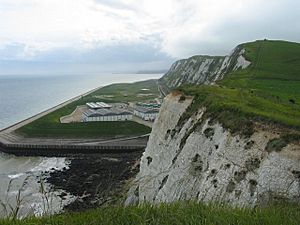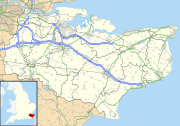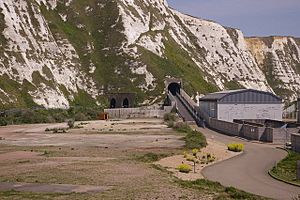Samphire Hoe facts for kids
Samphire Hoe is a special country park located near Dover in Kent, England. It's about 2 miles west of Dover. This park was made using a huge amount of chalk and rock. This material came from digging the Channel Tunnel, which connects England and France.
You can find Samphire Hoe right at the bottom of the famous White Cliffs of Dover. The land is owned by Getlink, the company that runs the Channel Tunnel. It is looked after by the White Cliffs Countryside Project.
To get to the park, you drive through a single-track tunnel. This tunnel has traffic lights to control cars. It goes over the South Eastern Main Line railway, which runs in a tunnel underneath. Once you arrive, there are places to park your car, toilets, and a small tea kiosk.
Contents
What Does the Name Samphire Hoe Mean?
Samphire Hoe gets its name from a wild plant called rock samphire. This plant used to be gathered from the cliffs around Dover. Its green leaves were picked in May. People would pickle them in salty water and send them to London. There, they were eaten with meat.
The word 'hoe' means a piece of land that sticks out into the sea. So, Samphire Hoe is a place sticking out into the sea where rock samphire once grew. The name was chosen in a public competition. A retired teacher from Dover, Mrs. Gillian Janaway, came up with it.
The History of Samphire Hoe
The cliffs above Samphire Hoe have an interesting past. In 1843, part of Round Down Cliff was blown up with gunpowder. This was done to help build the railway line between Dover and Folkestone.
Later, in 1880, people tried to dig a tunnel from this spot. Their goal was to create a tunnel under the English Channel. However, this attempt did not last long. In 1895, a coal mine was started here, but it wasn't very successful and closed in 1921.
These old activities were served by a train station called Shakespeare Cliff Halt railway station. You can still see parts of the old train platforms from the road that leads to the park's car park. Long ago, a small community of fishers and other people lived at the base of Shakespeare Cliff.
In the 1980s, Samphire Hoe was chosen as the best place to put the chalk dug out from the Channel Tunnel. Work started in 1988. The park covers 30 hectares of land. This land was completely made from scratch, reclaimed from the sea. The first step was to build strong walls in the sea. These walls created an artificial lagoon where the chalk could be placed.
The Channel Tunnel was finished in 1994. It was officially opened by Queen Elizabeth II and French President François Mitterrand. Samphire Hoe park then opened to the public in 1997. It is also home to the cooling station for the English side of the Channel Tunnel. This station helps keep the tunnel cool.
Visiting Samphire Hoe
Today, Samphire Hoe attracts about 110,000 visitors every year. There are many fun things to do there. You can go walking, cycling, or even fishing on the sea wall. It's also a great spot for bird watching.
The park is open every day from 7 AM until dusk. Entry to the park is free. There is a small charge of £2 for parking your car. The paths are very friendly for wheelchairs, making it easy for everyone to explore. There is also an education room that schools can use for learning activities.
Samphire Hoe is managed by the White Cliffs Countryside Project. They work together with the owner, Getlink, to keep the park beautiful and safe for wildlife.
Exploring the Walking Trail
Samphire Hoe has a walking path that goes all the way around the park. The full circuit is about 2 kilometers (1.2 miles) long. The path has gentle slopes, making it easy to walk or cycle.
The main nature trail is made of tarmac with fine gravel. The path along the seawall is smooth concrete. Sometimes, the area is used for jogging and fun runs during special events.
Wildlife and Nature
Samphire Hoe is a wonderful place for wildflowers and birds. It has become a chalk meadow-land. You can find several rare plant species here, like the early spider orchid. Every July, the beautiful rock sea lavender blooms. You can also see the rock samphire plant that the park is named after.
Many different birds visit the cliffs and meadows. You might spot Peregrine falcons flying high above the cliffs. Stonechats and meadow pipits can be seen in the meadow. Rock pipits often move along the base of the cliffs. House martins build their mud nests under the overhangs of the chalk cliffs.





